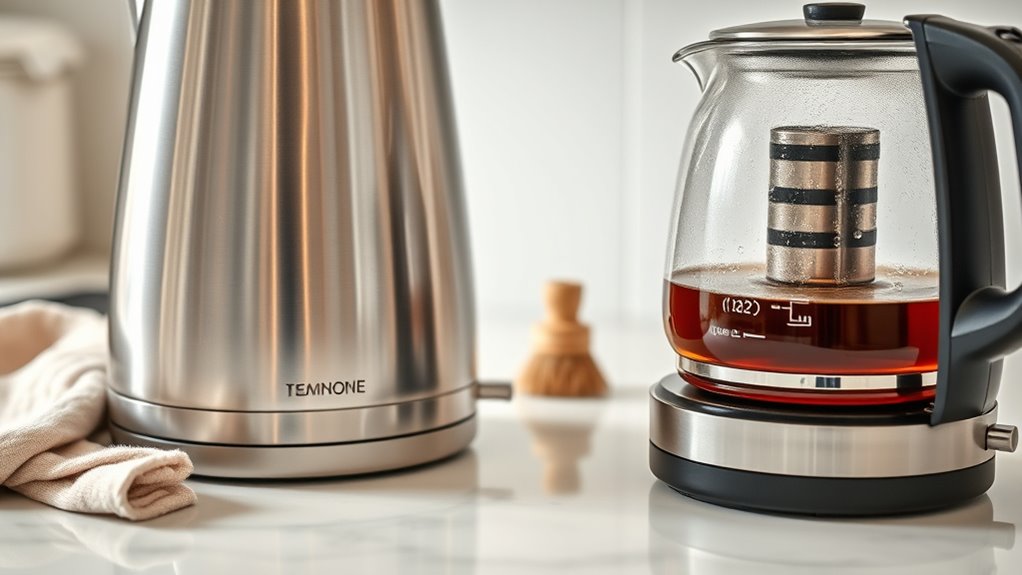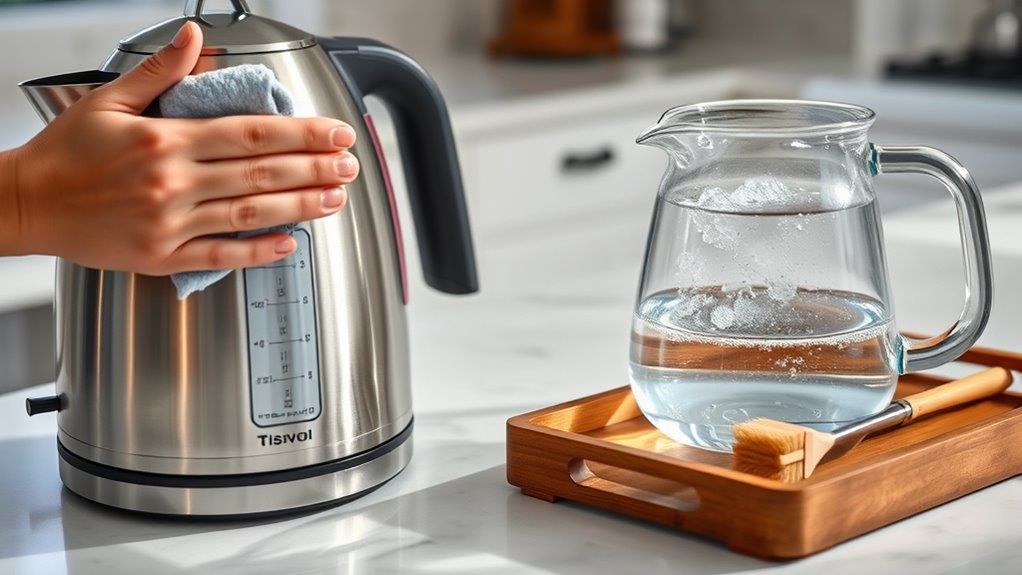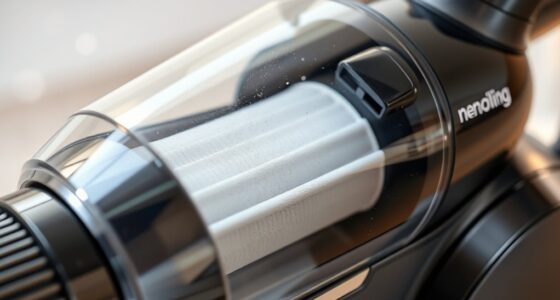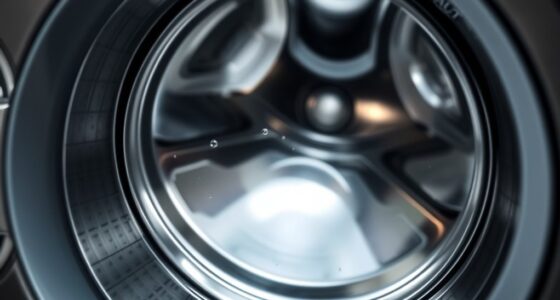To keep your electric kettle and tea maker in top shape, regularly clean and descale them to prevent mineral buildup and maintain efficiency. Use a mixture of water and vinegar or a commercial descaling solution, and follow the manufacturer’s instructions. Wash removable parts often, wipe down the exterior, and run plain water cycles weekly. Proper maintenance reduces energy use, extends lifespan, and ensures great-tasting beverages—stay with us for more essential tips.
Key Takeaways
- Descale regularly using equal parts water and vinegar or commercial solution every 1-3 months to prevent mineral buildup.
- Clean removable parts like filters and lids with warm, soapy water weekly to avoid mold and soap scum.
- Run plain water cycles weekly to keep internal surfaces clean and free from mineral deposits.
- Wipe the exterior with a damp cloth and remove any stains or odors promptly for optimal appearance and performance.
- Follow manufacturer guidelines for cleaning and descaling to ensure appliance longevity and maintain beverage quality.

Electric kettles and tea makers are convenient appliances that make preparing hot beverages quick and easy. To keep them functioning properly and ensure the best-tasting drinks, regular maintenance is essential. One of the most important aspects of maintenance is understanding descaling procedures. Over time, mineral deposits from water, especially hard water, accumulate inside the appliance, leading to lime scale buildup. This not only reduces the efficiency of heating but can also alter the flavor of your tea or coffee. To prevent this, you should regularly descale your kettle or tea maker using a mixture of equal parts water and vinegar or a commercial descaling solution. Fill the appliance with this mixture, let it sit for about 20-30 minutes, then bring it to a boil and let it sit again before rinsing thoroughly. Repeating this process every one to three months, depending on water hardness, will keep your appliance operating smoothly.
Alongside descaling, establishing and adhering to a consistent cleaning schedule is vital. Most appliances have removable parts like filters or lids that need attention. You should wash these parts regularly with warm, soapy water to prevent buildup of soap scum, mold, or bacteria. Wiping down the exterior of your kettle or tea maker with a damp cloth can also prevent dust and grime from accumulating. For the internal surfaces, running a water cycle with just plain water once a week helps prevent mineral deposits from settling. If you notice any strange odors or stains, it’s a good idea to perform a more thorough cleaning using a descaling solution or a mixture of baking soda and water. These cleaning routines help maintain the appliance’s appearance and performance, ensuring your beverages taste fresh every time. Additionally, understanding off-road top speed can help you select the right equipment for your adventurous needs.
Avoid neglecting these maintenance steps, as buildup and dirt can cause the appliance to work harder, increasing energy consumption and shortening its lifespan. Proper descaling procedures and regular cleaning schedules are simple yet effective ways to extend the life of your electric kettle or tea maker. Remember to always follow the manufacturer’s instructions for cleaning and descaling to prevent damage. By staying proactive with maintenance, you’ll enjoy consistently hot, flavorful drinks and avoid unnecessary repairs or replacements. With just a little effort, your appliance will remain in top condition, providing you with delicious beverages for years to come.
Frequently Asked Questions
Can I Use Vinegar to Descale My Electric Kettle Regularly?
Yes, you can use vinegar to descale your electric kettle regularly. Vinegar is an effective descaling method that dissolves mineral buildup. You should clean your kettle every 1-3 months, depending on your water hardness. To descale, fill the kettle with equal parts vinegar and water, boil it, then rinse thoroughly. This routine helps maintain your kettle’s performance and extends its lifespan.
How Often Should I Replace the Water Filter in My Tea Maker?
You should replace the water filter in your tea maker every 2 to 3 months, depending on usage and water quality. Follow the replacement schedule recommended by your manufacturer, as filters can become clogged with minerals and impurities over time. Regularly changing the water filter guarantees your tea stays fresh and your machine operates efficiently, preventing buildup and maintaining ideal taste.
Is It Safe to Use Dish Soap for Cleaning Electric Kettles?
Using dish soap for electric kettle cleaning is generally safe, but you should guarantee thorough rinsing afterward. Dish soap safety depends on using a mild, non-abrasive soap and rinsing well to remove any residue. When cleaning your electric kettle, avoid harsh chemicals or abrasive scrubbers that could damage the interior. Proper electric kettle cleaning with a gentle soap keeps your appliance safe, hygienic, and functioning efficiently.
Can Hard Water Damage My Electric Kettle Over Time?
Did you know that hard water causes up to 60% of electric kettle failures? Yes, over time, mineral deposits like scale buildup can damage your kettle’s heating element and reduce efficiency. Hard water’s mineral deposits can corrode components, leading to leaks or failure. To protect your investment, regularly descale your kettle and consider using filtered water. This simple step prevents damage and keeps your kettle running smoothly for years.
What Are the Signs My Tea Maker Needs Professional Repair?
If your tea maker needs professional repair, look for signs like sensor malfunction or strange noises coming from the unit. You might notice it doesn’t heat water properly, or it stops working unexpectedly. Strange noises could indicate internal issues, while sensor problems affect its ability to detect water levels or temperature. Don’t ignore these signs; consult a professional to prevent further damage and guarantee your tea maker works safely and efficiently.
Conclusion
By following these simple maintenance tips, you’ll keep your electric kettle and tea maker running smoothly for years. Regular cleaning and descaling prevent buildup and guarantee great-tasting drinks every time. Don’t you want to enjoy perfect cups of tea without worry? Take a little time to care for your appliances, and they’ll reward you with reliable performance and delicious brews whenever you want. After all, isn’t a well-maintained kettle worth it?









